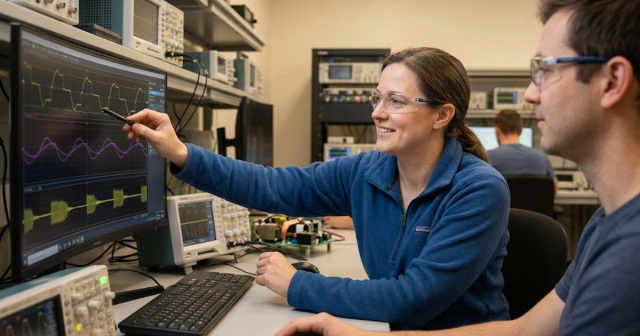Power grid simulation is the missing piece for quantum computing
Power Systems
07 / 28 / 2025

Quantum computing just achieved a milestone that could fundamentally change how we keep the lights on. Engineers have recently demonstrated the quantum entanglement of two electrons on a single silicon chip, an unprecedented feat that signals quantum technology moving beyond the lab. We view breakthroughs like this as more than scientific curiosities; they are stepping stones toward solving the complexity and reliability challenges plaguing today’s electric grids. Pairing these advances with high-fidelity, real-time power system simulation allows the energy sector to unlock levels of stability and efficiency that conventional approaches alone could never achieve.

Quantum breakthrough validates utility-scale potential
For the first time, researchers entangled qubits inside a conventional silicon microchip, confirming that practical, scalable quantum processors are within reach. Accomplishing entanglement in silicon means quantum bits can leverage the same fabrication techniques as everyday computer chips. This paves the way to pack more quantum information into smaller devices and scale up to the millions of qubits needed for meaningful applications. The milestone—published in Nature—is a crucial step toward “utility-scale” quantum computers capable of tackling problems with true societal and commercial value.
This recent quantum breakthrough is not just academic—it has direct implications for the power industry’s future. Utility operators confront optimization puzzles so massive that no classical supercomputer can solve them in real time. The emergence of silicon-based quantum computing suggests that, before long, we could have machines able to handle these impossible calculations. Technology born from quantum physics might soon be stabilizing the very real flow of electricity to our homes and cities.
“Power grids are reaching a complexity that pushes even today’s most powerful computers to their limits.”
Complex energy systems outgrow traditional solutions
Modern power grids have become astonishingly complex, stretching legacy control tools to their limits. Grid operators are grappling with challenges that traditional computing can no longer manage. One engineer observed that with millions of devices and data points now in play, classical optimisers start to show their limits while quantum methods begin to shine. Renewable generation, electric vehicles, and connected appliances have turned electricity networks into high-dimensional, constantly shifting systems that conventional algorithms struggle to stabilize. Below are several key pain points overwhelming the status quo:
- Exponential network scale: Power systems now incorporate vast numbers of distributed energy resources—solar panels, batteries, EV chargers, advanced inverters—adding millions of new inputs to grid management. This scale of complexity is far beyond what previous-generation planning tools were designed to handle.
- Volatile supply and load: The output from wind and solar farms can swing sharply, and consumer power consumption is less predictable than ever. Sudden shifts in generation or load expose the grid to frequency and voltage fluctuations that traditional control systems react to slowly, risking stability.
- Bidirectional power flow: Unlike the one-way flow of electricity in old grids, today’s networks see energy flowing both from central plants outward and from rooftop systems and batteries back into the grid. This bidirectional flow creates unpredictable conditions—such as reverse currents and over-voltages in distribution lines—that legacy protections and models struggle to accommodate.
- Computational bottlenecks: Critical decisions such as optimal power dispatch, contingency analysis, or real-time reconfiguration involve solving enormous optimisation problems. Classical algorithms often require simplifications or take too long to compute, forcing grid operators to operate suboptimally or with incomplete information.
- Reliability strain under extremes: Extreme weather and peak load events now push aging infrastructure to the brink. With current tools, operators cannot always simulate and prepare for every contingency fast enough. The result is heightened risk of cascading outages or the need for load curtailment when conditions deviate from what conventional models can predict.
These pain points leave energy networks vulnerable to inefficiencies and instability. The fundamental issue is a gap between the grid’s exploding complexity and the limited problem-solving capability of classical computing. Closing this gap requires a new approach that can explore vast solution spaces and respond in real time, an approach that merges next-generation computation with sophisticated simulation.

Quantum computing and real-time simulation overcome grid challenges
By combining emerging quantum algorithms with high-fidelity real-time simulation, utilities can finally tackle these challenges head-on. This synergy addresses core issues by unlocking capabilities unattainable with either technology on its own.
Accelerating complex optimisation
Quantum computers excel at exploring many possibilities simultaneously, something classical machines cannot do in reasonable time. Tasks like optimal power flow or grid reconfiguration—once intractable at full scale—can be solved orders of magnitude faster by quantum solvers. Researchers have already linked quantum processors with live grid simulators to test this potential. In practice, a real-time simulator continuously feeds the quantum engine with the grid’s state, and the quantum side crunches through combinatorial optimisations to suggest ideal control actions. The result is a dramatic acceleration in reaching the best decisions for scenarios like rerouting power around outages or balancing thousands of distributed generators, yielding solutions that keep the system stable and efficient.
Anticipating grid instabilities
The fusion of quantum computing with simulation also unlocks unprecedented foresight. Real-time digital simulators can emulate an entire electrical network under myriad conditions, while quantum algorithms almost instantaneously evaluate each scenario’s outcome. This means operators could explore countless “what-if” situations—from sudden generator failures to extreme weather impacts—and get optimal mitigation strategies nearly immediately. Armed with such predictive insight, grid controllers can pre-empt instabilities before they escalate. For example, if a major storm threatens a region, a quantum-enhanced simulation might swiftly identify how to reroute power and adjust resources to prevent blackouts, providing a level of resilience unavailable through classical contingency analysis alone.
Enhancing efficiency and reliability
Perhaps most importantly, the quantum-plus-simulation approach drives a more adaptive, more reliable grid day-to-day. Quantum optimisers can sift through enormous data sets to fine-tune system settings—voltage setpoints, battery dispatch schedules, network configurations—in ways that minimise losses and costs while maximising reliability. These algorithms, coupled with real-time models, continually hunt for better operating points that traditional control software would miss. Over time, small efficiency gains compound into significant cost savings and emissions reductions, all while reinforcing system stability. And because real-time simulators act as a safe testbed, engineers can validate quantum-derived solutions in a virtual grid before deploying them, ensuring that new strategies bolster reliability under real conditions.
“This synergy addresses core issues by unlocking capabilities unattainable with either technology on its own.”
Quantum advantage is within reach for energy systems
Not long ago, applying quantum computing to utility grids seemed purely theoretical. Today, early projects are proving that quantum advantage in energy is more than a buzzword—it’s becoming reality. Power and technology organizations have begun experimenting with quantum-assisted grid control. In one pioneering pilot, a major utility partnered with a quantum computing firm to optimise where to install large batteries on the network. Over a ten-month trial, some quantum algorithms actually matched or beat the performance of classical methods in maximizing grid reliability and voltage control. Achievements like this hint that quantum processors will soon solve certain power flow and planning problems faster, or more effectively, than any classical computer can.
Momentum is building. Government and academic teams have already demonstrated quantum-in-the-loop simulations, directly interfacing prototype quantum hardware with grid equipment in real time. Each new qubit milestone and successful trial narrows the gap between theory and practical deployment. The implications for energy are profound: as quantum computing power grows, so does our ability to manage sprawling, dynamic electrical networks with a precision and adaptability never before possible. The long-elusive goal of an optimally efficient, self-stabilizing grid is finally within sight, propelled by innovations uniting advanced computation with real-time system insight.

OPAL-RT pioneering the integrated future of grid simulation and quantum
As quantum advantage moves from promise to reality, OPAL-RT is working to ensure this potential translates into a more resilient energy infrastructure. We have always focused on bridging cutting-edge physics with practical engineering to strengthen critical systems. Now, the emergence of accessible quantum technology represents the next frontier in that mission. Our real-time simulation platforms are already designed to connect with external computing engines, which means they can serve as the perfect playground for quantum-assisted control strategies. In essence, we make it possible for energy providers to experiment safely with quantum algorithms today so they can deploy them confidently tomorrow.
For example, the OPAL-RT team is part of an Australian consortium directly linking a small quantum processor with live power system simulation. This collaborative project—involving university researchers, industry experts, and grid operators—allows quantum algorithms to be tested on highly realistic grid models without risking any actual infrastructure. Uniting these different experts to integrate quantum advances helps accelerate the arrival of a more intelligent, resilient power grid sooner than many would expect. Each breakthrough in quantum computing is not just a laboratory triumph for us; it’s a beacon lighting the way to a stronger, more adaptive electrical grid that benefits everyone.
Common Questions
How does quantum computing improve power grid optimization?
Quantum computing enhances power grid optimization by solving complex, high-dimensional problems that classical systems struggle with. It can evaluate multiple control strategies simultaneously, making it possible to quickly identify optimal solutions for energy dispatch, grid stability, and contingency planning. This is especially valuable when managing the unpredictable behaviour of renewable sources. OPAL-RT supports this integration through simulation platforms that interact with quantum engines to validate results under real-time conditions.
Can quantum computing help with real-time simulation in energy systems?
Quantum computing complements real-time simulation by handling optimization workloads that require extraordinary computational depth. While real-time simulators model the behaviour of the grid minute by minute, quantum algorithms can assess control scenarios that would overwhelm classical solvers. This pairing empowers energy operators to make better-informed decisions faster. OPAL-RT plays a key role in facilitating this synergy by providing open and scalable real-time simulation tools for validation and testing.
What’s the business case for using quantum computing in grid reliability?
The business value lies in reducing outages, enhancing system efficiency, and optimizing capital planning. With quantum computing, utilities can simulate thousands of potential grid failure or congestion scenarios and receive reliable mitigation strategies in seconds. These faster insights can lower operational costs, reduce penalties, and support regulatory compliance. OPAL-RT enables these outcomes by allowing engineers to test and refine quantum-enhanced strategies before live deployment.
Why aren’t traditional computing methods enough for power systems?
Traditional computing methods are limited by their linear and sequential processing, which becomes a bottleneck when facing the complexity of distributed energy resources and bi-directional power flows. These limitations affect how fast and accurately operators can plan, simulate, and respond to dynamic grid changes. Quantum computing bypasses these constraints through parallelism, and when combined with real-time simulation—like those developed with OPAL-RT—it unlocks better solutions faster.
When will quantum computing be ready for my utility?
Quantum hardware is maturing rapidly, and pilot programs are already underway in the energy sector. While full-scale deployment may take a few years, simulation-led collaborations let utilities start experimenting today. OPAL-RT supports these efforts by enabling real-time emulation environments where quantum algorithms can be safely tested and improved without affecting live grid infrastructure.
EXata CPS has been specifically designed for real-time performance to allow studies of cyberattacks on power systems through the Communication Network layer of any size and connecting to any number of equipment for HIL and PHIL simulations. This is a discrete event simulation toolkit that considers all the inherent physics-based properties that will affect how the network (either wired or wireless) behaves.


